Digging Deep into 2019 Outdoor Recreation Participation Stats
- June 6, 2019
- By Team Realtree
- Research

We frequently share a lot of outdoor recreation participation data with you here at the Realtree Business Blog. Studying participation numbers and trends helps all of us in the industry to understand who and where our marketing efforts should be targeting.
For example, knowing that the number of bowhunters has increased by 5% during the past decade and that females now account for 15% of license sales in a given region and that 20% of them are under the age of 24 is good to know if you’re crafting a message to reach that segment of shoppers at retail. But, what’s even more helpful is looking at frequency participation, which gives a clearer picture of how many of those potential customers are actually avid participants.
The National Sporting Goods Association is doing its best to drill down into real participation levels, sports by sport, activity by activity. A few years ago, this Illinois-based trade organization expanded its extensive research offerings by providing a new measurement of sports participation based on Total Participation Points.
Total Participation Points (TPP) is what the NSGA calls a “superior method” of comparing segments of sports and activities over a period of time. From the NSGA’s 2019 report: “The benefit of TPPs is it measures both the reach and the depth of participation. In other words, this measure not only takes into consideration the number of people participating within the segment (reach), but also the number of sports/activities each person is participating in (depth).”
To understand the practical application of such a measurement, here’s another hunting participation example. We’ve noted in earlier posts that pointing to license sales data alone can be misleading when trying to evaluate market size. As recently explained here, not every person who considers himself or herself a hunter buys a license each year. While it’s estimated that there are approximately 21 million hunters in the U.S., annual license sales can be several million units lower.
In this and future blog posts, we’ll break down some findings from the most recent NSGA study, which is based on statistics through 2018. The study is based on surveys of approximately 34,000 individuals age 7 and older. As explained in the report’s Methodology section, the data is weighted to represent the demographic composition of the U.S. based on state of residence, household income and population density. The returns were then project to 297,733,000, which was the U.S. population age 7 and older in 2018.
While the NSGA study covers 57 activities and sports across nine categories, we’ll focus on 15 activities across four categories: Outdoor, Shooting, Open Water, and Fitness. We’ll go into the details of the activities that comprise these four categories in future posts, but here’s a snapshot of the trends for each of them:
TOTAL PARTICIPATION POINTS (in millions)
|
|
1990s |
2000s |
2010s |
% Change from 2017 |
TPP Change 2014-18 |
|
Outdoor |
134 |
140 |
134 |
+0.8% |
+7 |
|
Shooting |
53 |
64 |
64 |
-1.6% |
-2 |
|
Open Water |
46 |
47 |
38 |
+1.3% |
+4 |
|
Fitness |
183 |
227 |
280 |
+1.4% |
+12 |
A final general comment before we dig further into the details, directly from the report:
“Only the Fitness Activity segment has shown consistent growth since the 1990s. Although sporting goods sales continue to grow, all of us as an industry need to remain focused on ways to increase participation to ensure the future health of the industry.”
In the next installment of this series, we’ll look at participation statistics in the Outdoor category, which includes backpack/wilderness camping, vacation/overnight camping, freshwater fishing, saltwater fishing and hiking.
Editor’s Note: Realtree, the world’s No. 1 camo company, wants to help you grow your business. We have solutions whether you’re a manufacturer, wholesaler or retailer. To find out how Realtree branding can help you increase sales, contact us today!
